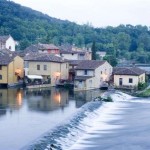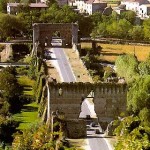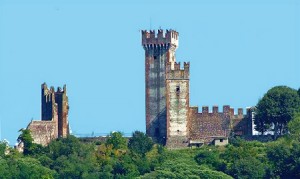Valeggio sul Mincio extends between the green Morainic Hills of lake Garda (Colline Moreniche del Garda),
TERRITORY OF VALEGGIO SUL MINCIO
Hamlets: Borghetto, Fontanello, Foroni, Salionze, Santa Lucia ai Monti, Vanoni e Remelli
Bordering municipalities: Castelnuovo del Garda, Marmirolo (Mn), Monzambano (Mn), Mozzecane, Peschiera del Garda, Ponti sul Mincio (Mn), Roverbella (Mn), Sommacampagna, Sona, Villafranca, Volta Mantovana (Mn).
HISTORY OF VALEGGIO SUL MINCIO
There are many tracks that evidence of human presence in the Mincio Valley as early as the Bronze Age, as well as several graves dating to the Iron Age, is significant the discovery of a large necropolis in the Celtic still below the current town which brings us back to the fourth century BC
 Valeggio and Borghetto became urban centers in Longobard times, it can also be deduced by the same names that would mean respectively “level place” and “fortified settlement”. At the turn of the tenth and eleventh centuries, this territory came under the Kingdom of Germany. Its privileged geographic location will give Valeggio for centuries a strategic role in the military point of view, as it leads the Venetian and the hinge between the two fortresses of Mantua and Peschiera. Between 1200 and 1300 were built the Scaligero Castle and the Visconti Bridge, which still dominate the country giving a medieval atmosphere.
Valeggio and Borghetto became urban centers in Longobard times, it can also be deduced by the same names that would mean respectively “level place” and “fortified settlement”. At the turn of the tenth and eleventh centuries, this territory came under the Kingdom of Germany. Its privileged geographic location will give Valeggio for centuries a strategic role in the military point of view, as it leads the Venetian and the hinge between the two fortresses of Mantua and Peschiera. Between 1200 and 1300 were built the Scaligero Castle and the Visconti Bridge, which still dominate the country giving a medieval atmosphere.
From the fifteenth to the late eighteenth century is Valeggio dominion of the Serenissima Republic of Venice, becoming in time a place of military garrison in agricultural center and milling, also renowned for the market of silkworms.
With the end of the Venetian Republic and after the Napoleonic battles, Valeggio passed in 1815 along with Lombardy and Veneto in the Austrian Empire. With the Risorgimento the hills of Valeggio will be the scene of the three wars of Independence (1848 – ’59-’66) that led to the creation of the Kingdom of Italy under the Savoy monarchy.


